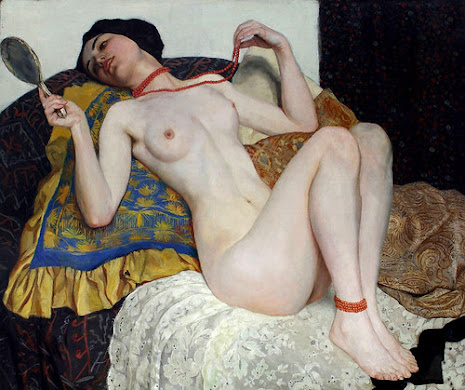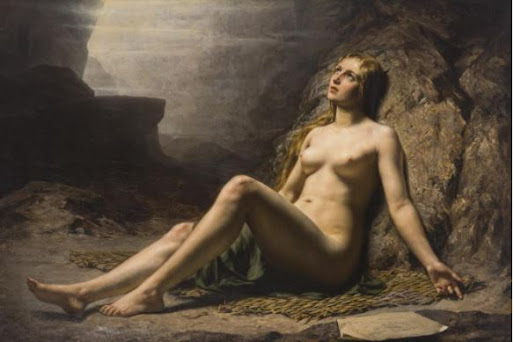John Singer Sargent's, three Venice street scenes
'A Street Scene in Venice', 1882 oil on wood, John Singer Sargent (1856-1925) (Model: Gigia Viani)
Painted in a post-impressionist manner, it is set in a quiet backstreet off the Calle Larga dei Proverbi, near the Grand Canal in Venice. The painting shows a young woman walking along the flagstones, kicking her skirt with her right foot, and observed by two men in the shadows to her right. From the manner in which Sargent depicts her down-turned eyes and seemingly fast pace with which she passes the two men, he is concerned largely with the invasive male glare and its effect on the passing woman.
The woman is observed by two intimidating, darkly coloured men huddled in conversation to the right of the frame. In the middle background a couple are seated outside of a cafe or bar, also deep in conversation. The couple are interested only in themselves, in contrast to the two men. Their gaze follows the girl, while her downcast eyes deliberately avoid their attention. Her shawl and skirt hem are shown flowing, suggesting that she is moving quickly past them. The Venice setting is significant; the artist has placed the moment away from the cosmopolitan surroundings of London, Paris or New York – cities more familiar to him and which he considered more refined.
In its use of broad dark areas silhouetted against lighter ground used to give shape to the figures, it seems influenced by Velázquez. That Sargent was influenced by photography of Venice, in particular by the works of Carlo Naya (1816–1882), can be seen the way the painting is closely cropped, and in the almost photographic freeze-frame capturing of movement in a moment in time.[7]
The painting is composed as a series of descending rectangles arranged in a near-telescopic manner, outside of which a section of blue sky lightens the claustrophobic tone marked by the descending angles which meet at the girl's head. It is largely rendered in monochrome, though there are touches of red in the girl's head comb, dress and in the cafe behind her. However, overall the artist is more concerned with tone than colour.
Additional information by Natasha Wallace (JSSGallery.org)
 This is street-life on a chilly day in the fall or winter with men in top coats and the woman in a warm wrap, on an old narrow street with locals who talk to their neighbors. The National Gallery of Art, where this painting hangs, indicates this was painted at Calle Larga dei Proverbi, a back alley north of the Grand Canal and behind the church of SS. Apostoli (Linda Ayres, Patricia Hills Book, P. 56). They seem to think it was painted during siesta because, as you can see, the shop doors are closed and there are few people on the street. Though the tonality is very dark, and the shadows deep, which might give it a moody Sortie de l’église,Campo San Canciano, Venice feeling, the subject is far from what the mood might indicate. If you compare Sortie de l’église, Campo San Canciano, Venice (1882) with Street in Venice you will see women headed home (from church no less) in roughly the same outfit as the young woman in Street in Venice. This is what women wore and how they wore it.
This is street-life on a chilly day in the fall or winter with men in top coats and the woman in a warm wrap, on an old narrow street with locals who talk to their neighbors. The National Gallery of Art, where this painting hangs, indicates this was painted at Calle Larga dei Proverbi, a back alley north of the Grand Canal and behind the church of SS. Apostoli (Linda Ayres, Patricia Hills Book, P. 56). They seem to think it was painted during siesta because, as you can see, the shop doors are closed and there are few people on the street. Though the tonality is very dark, and the shadows deep, which might give it a moody Sortie de l’église,Campo San Canciano, Venice feeling, the subject is far from what the mood might indicate. If you compare Sortie de l’église, Campo San Canciano, Venice (1882) with Street in Venice you will see women headed home (from church no less) in roughly the same outfit as the young woman in Street in Venice. This is what women wore and how they wore it.
I am reminded of a famous photograph of a street in Paris in the 1940's which showed a beautiful young woman that had passed a group of young men all of whom are admiring her. Boys will be boys -- though I’m not sure it’s politically correct to say that. Remember, Sargent is 26 years old when he paints this, and I don’t think it beyond him to also enjoy the sight of a beautiful woman in a fleeting moment.
But more importantly, I think you need to keep in mind that this was done in the vernacular of the great Spanish Master Diego Velazquez (1599-1660), whom John admired greatly and was influenced by.
In 1629, at the age of 30, Velazquez took a trip from Spain to Italy and studied the masters and painted there for two years. He visited, among other places, Venice, Florence, and Rome.
In 1882, Sargent travels to Venice, Florence, Siena, and Rome at a relatively similar time in his life, and I don't think this was lost on him. During this period, Sargent is actively studying and experimenting with the great Master's form and style. What Velazquez was able to captured was the deep, deep tonality of earthy colors, almost monochromatic in some cases, and the ability to freeze or capture the instantaneousness of people, of expressions, of movement. Velazquez was living at a time when the Spanish empire was near bankrupt and beginning to crumble and his paintings could be often moody in a dark tonal sense
In 1883, Sargent sent A Street in Venice to the Societe Internationale des Peintres et Sculpteurs, Rue de Seze, Paris. One critic called Sargent's work "banal and worn-out". 'M. Sargent leads us into obsure squares and dark streets where only a single ray of light falls. The women of his Venice, with their messy hair and ragged clothes, are no decendents of Titian's beauties. Why go to Italy if it is only to gather impressions like these.'
This is the real Venice on a cool autumn or winter day. And knowing Sargent, though it might not be pretty at first impression, it is probably a very accurate depiction of local life.
"A Street in Venice", 1980-81, JSS, (Clark Art Institute, MA)
This narrow alleyway, with its peeling plaster walls and a burst of light at the far end, draws us into an ambiguous situation. A woman steps over the threshold of a wine cellar, looking out at us as if we have intruded on a private meeting. The man facing her seems unaware of being observed. This is one of nearly twenty paintings in which Sargent, instead of focusing on iconic views of Venice, offers a glimpse into everyday life.
'The Sulphur Match', 1882 (oil on canvas) JSS, Visita il Museo Correr, Collection of Marie and Hugh Halff, Jr.
This is unique amongst the artist’s Venetian paintings. Small in size and narrative in content, it evokes the atmosphere of a tavern. The painting shows a seated young woman leaning back against a wall as she looks flirtatiously at the young man lighting a cigarette. In the scene one can also see a bottle of wine and, in the lower left-hand corner, a broken glass. One of the few Venetian paintings to be dated, this is modern both in the relaxed pose of the figures and the atmosphere of calm intimacy. The title refers to the lit match held by the male figure.








Comments
Post a Comment